“Global Cloud Gaming Market to reach a market value of USD 41.76 Billion by 2032 growing at a CAGR of 43.7%”
The Global Cloud Gaming Market size is expected to reach $41.76 billion by 2032, rising at a market growth of 43.7% CAGR during the forecast period.
By offloading game processing to remote data centers, gamers can enjoy graphically demanding titles on basic devices such as smartphones, tablets, and low-spec PCs. This capability has expanded the addressable user base for cloud gaming services, particularly among casual gamers and those in emerging markets who may not own gaming consoles or powerful computers. Additionally, subscription-based cloud gaming services using video streaming have enabled players to access extensive game libraries, encouraging higher user engagement and retention.
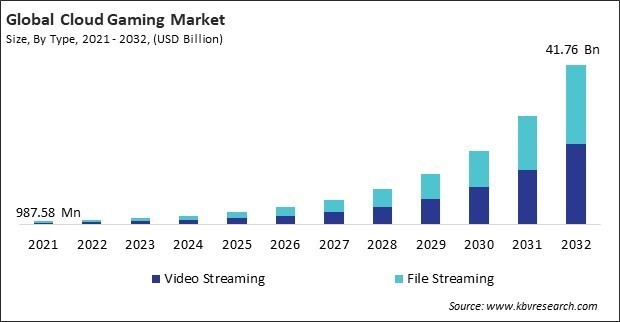
The major strategies followed by the market participants are Product Launches as the key developmental strategy to keep pace with the changing demands of end users. For instance, In January, 2025, Apple has launched new features allowing apps to deliver streaming games, mini-apps, and chatbots worldwide. Developers can now submit apps with game catalogs and enable in-app purchases. The update improves game discovery, user experience, and provides new analytics tools for developers. Moreover, In January, 2025, Advanced Micro Devices, Inc. has launched its latest gaming processors, including the Ryzen 9950X3D, 9900X3D, and Ryzen Z2, designed for desktop, mobile, and handheld systems. These new products deliver enhanced gaming performance, offering significant improvements for cloud gaming by optimizing hardware for remote game streaming.
Based on the Analysis presented in the KBV Cardinal matrix; Microsoft Corporation, Apple, Inc., NVIDIA Corporation, Meta Platforms, Inc. and Amazon Web Services, Inc. are the forerunners in the Cloud Gaming Market. Companies such as Tencent Holdings Ltd. and Sony Corporation are some of the key innovators in Cloud Gaming Market. In March, 2025, Amazon Web Services launched GameLift Streams, enabling video game publishers to stream games on various devices. Jackbox Games is an early adopter, planning a streaming service for smart TVs. The service supports 1080p resolution at 60 frames per second.
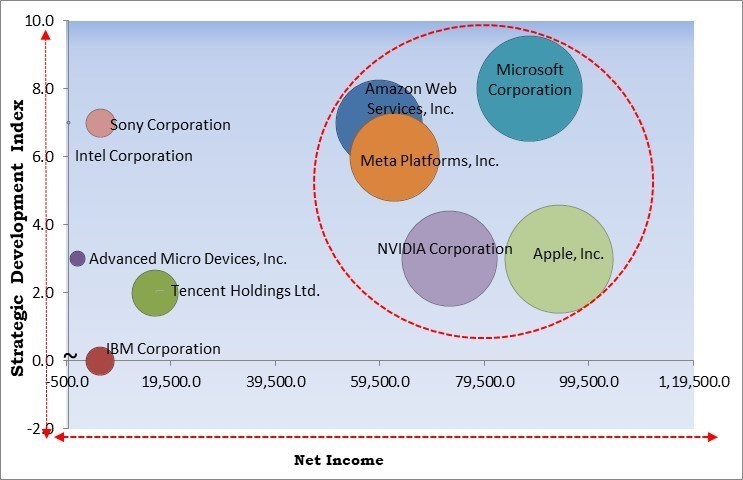
Cloud gaming aligns with rising consumer consciousness regarding sustainability by addressing several environmental concerns tied to traditional gaming. Manufacturing, distributing, and disposing gaming consoles and physical media contribute significantly to carbon emissions and e-waste. Cloud gaming mitigates these impacts by centralizing game processing in data centers and delivering content digitally, eliminating the need for resource-intensive hardware and physical game copies. Thus, cloud gaming’s environmental and space-saving benefits resonate with eco-conscious consumers, offering a sustainable alternative to traditional gaming setups.
Additionally, the growing availability of high-speed internet and widespread deployment of 5G networks fundamentally reshape the infrastructure landscape necessary for cloud gaming. Unlike traditional gaming, which relies on local processing power, cloud gaming streams content in real-time from remote servers, requiring a stable and fast internet connection to avoid latency and buffering. In many developed and emerging economies, the rollout of fiber-optic broadband and low-latency 5G has significantly enhanced connectivity. Therefore, the widespread adoption of high-speed internet and 5G networks significantly boosts the potential of cloud gaming, enabling smooth and high-quality gaming experiences across diverse regions.
However, One of the biggest challenges cloud gaming faces is its reliance on high-speed internet and substantial data consumption. Unlike traditional gaming, which only requires data transfer for online multiplayer functionality or periodic updates, cloud gaming streams entire game files in real-time. The process of rendering a game on remote servers and sending this data to a player’s device requires considerable bandwidth, often ranging from several megabits per second to gigabits, depending on the game’s resolution and quality settings. In conclusion, the high data consumption and bandwidth demands of cloud gaming create logistical and financial barriers for both users and internet service providers, limiting accessibility and adoption.
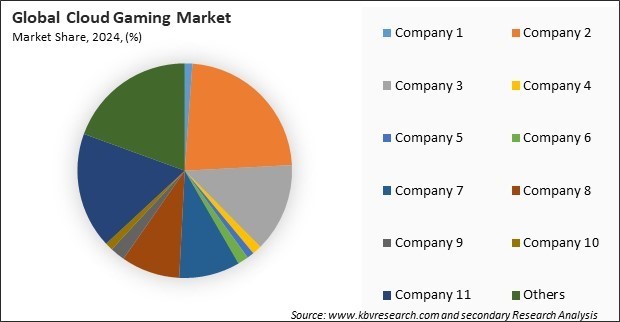
The leading players in the market are competing with diverse innovative offerings to remain competitive in the market. The above illustration shows the percentage of revenue shared by some of the leading companies in the market. The leading players of the market are adopting various strategies in order to cater demand coming from the different industries. The key developmental strategies in the market are Product Launches and Product Expansions.
Free Valuable Insights: Global Cloud Gaming Market size to reach USD 41.76 Billion by 2032
Based on type, the market is characterized into video streaming and file streaming. In this model, a portion of the game is downloaded and stored locally while additional content streams as needed, allowing for improved responsiveness and offline functionality. This hybrid approach appeals to gamers who seek reduced lag and more stable performance in bandwidth-constrained environments. File streaming is gaining traction because of its balance between local storage benefits and cloud-enabled flexibility, supporting its significant market presence.
By device, the market is divided into smartphones, gaming consoles, PCs & laptops, tablets, smart TVs, head-mounted displays, and others. This segment thrives as major console manufacturers integrate cloud gaming services into their ecosystems, offering users a broader range of games with minimal storage constraints. Cloud gaming enhances the functionality of consoles by enabling instant access to a vast library of titles and reducing the dependency on physical media or large digital downloads. Additionally, subscription-based cloud services bundled with consoles are attracting a growing base of dedicated players.
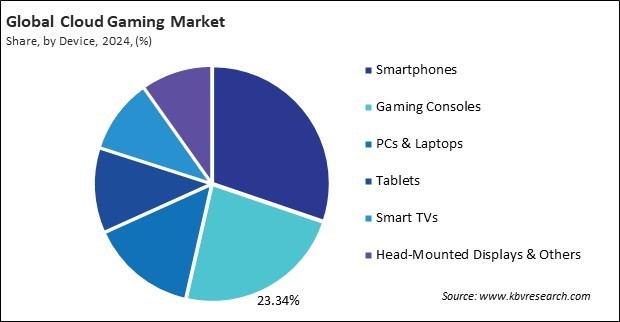
On the basis of gamer type, the market is classified into casual gamers, avid gamers, and lifestyle gamers. These users are more deeply engaged, often spending significant time on gameplay and seeking richer, more complex gaming experiences. Cloud gaming offers avid gamers the benefit of accessing high-end titles without the constant need for hardware upgrades, making it a practical and cost-effective solution. Enhanced streaming quality and reduced latency encourage avid gamers to shift toward cloud platforms for a seamless gaming experience.
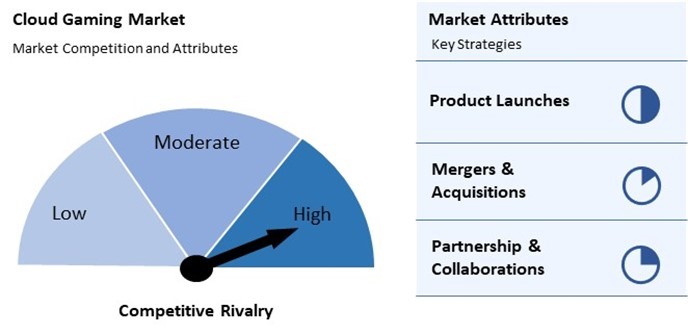
The cloud gaming market is highly competitive, driven by rapid advancements in technology and increasing demand for seamless gaming experiences. Companies compete by offering low-latency streaming, diverse game libraries, and cross-platform compatibility. Pricing models, including subscription-based and pay-per-use options, further intensify competition. New entrants leverage cloud infrastructure for scalability, while established players enhance user experience through AI-powered optimizations and edge computing. Strategic partnerships with telecom providers and content creators are also common, shaping the market’s dynamic and competitive landscape.
Region-wise, the market is analyzed across North America, Europe, Asia Pacific, and LAMEA. The Asia Pacific segment recorded 44% revenue share in the market in 2024. The rapid expansion of internet infrastructure, widespread smartphone adoption, and a large population of active gamers have significantly fuelled the region’s dominance. Countries like China, Japan, South Korea, and India are witnessing substantial investments in cloud gaming platforms and 5G networks, further driving market growth.
| Report Attribute | Details |
|---|---|
| Market size value in 2024 | USD 2.37 Billion |
| Market size forecast in 2032 | USD 41.76 Billion |
| Base Year | 2024 |
| Historical Period | 2021 to 2023 |
| Forecast Period | 2025 to 2032 |
| Revenue Growth Rate | CAGR of 43.7% from 2025 to 2032 |
| Number of Pages | 279 |
| Number of Tables | 374 |
| Report coverage | Market Trends, Revenue Estimation and Forecast, Segmentation Analysis, Regional and Country Breakdown, Competitive Landscape, Market Share Analysis, Porter’s 5 Forces Analysis, Company Profiling, Companies Strategic Developments, SWOT Analysis, Winning Imperatives |
| Segments covered | Type, Technology, Gamer Type, Device, Region |
| Country scope |
|
| Companies Included | Advanced Micro Devices, Inc., Microsoft Corporation, Amazon Web Services, Inc., IBM Corporation, Intel Corporation, Meta Platforms, Inc., NVIDIA Corporation, Sony Corporation, Tencent Holdings Ltd., Apple, Inc. and Google LLC |
By Type
By Gamer Type
By Device
By Geography
Our team of dedicated experts can provide you with attractive expansion opportunities for your business.

 Drivers
Drivers
 Restraints
Restraints
 Opportunities
Opportunities
 Challenges
Challenges
